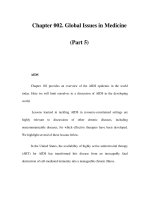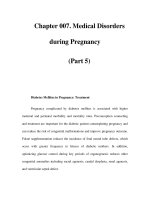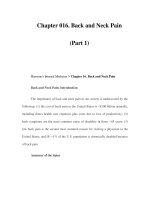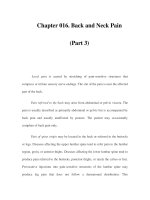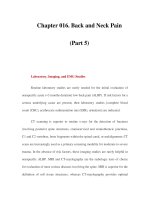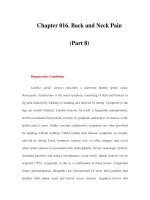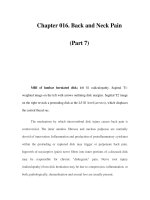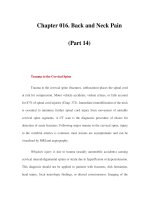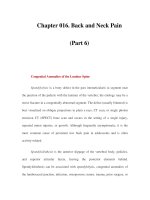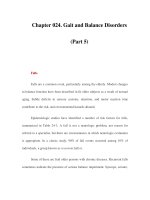Chapter 033. Dyspnea and Pulmonary Edema (Part 5) pps
Bạn đang xem bản rút gọn của tài liệu. Xem và tải ngay bản đầy đủ của tài liệu tại đây (76.14 KB, 7 trang )
Chapter 033. Dyspnea and
Pulmonary Edema
(Part 5)
Distinguishing Cardiovascular from Respiratory System Dyspnea
If a patient has evidence of both pulmonary and cardiac disease, a
cardiopulmonary exercise test should be carried out to determine which system is
responsible for the exercise limitation. If, at peak exercise, the patient achieves
predicted maximal ventilation, demonstrates an increase in dead space or
hypoxemia (oxygen saturation below 90%), or develops bronchospasm, the
respiratory system is probably the cause of the problem. Alternatively, if the heart
rate is >85% of the predicted maximum, if anaerobic threshold occurs early, if the
blood pressure becomes excessively high or drops during exercise, if the O
2
pulse
(O
2
consumption/heart rate, an indicator of stroke volume) falls, or if there are
ischemic changes on the electrocardiogram, an abnormality of the cardiovascular
system is likely the explanation for the breathing discomfort.
Dyspnea: Treatment
The first goal is to correct the underlying problem responsible for the
symptom. If this is not possible, one attempts to lessen the intensity of the
symptom and its effect on the patient's quality of life. Supplemental O
2
should be
administered if the resting O
2
saturation is ≤90% or if the patient's saturation drops
to these levels with activity. For patients with COPD, pulmonary rehabilitation
programs have demonstrated positive effects on dyspnea, exercise capacity, and
rates of hospitalization. Studies of anxiolytics and antidepressants have not
demonstrated consistent benefit. Experimental interventions—e.g., cold air on the
face, chest wall vibration, and inhaled furosemide—to modulate the afferent
information from receptors throughout the respiratory system are being studied.
Pulmonary Edema
Mechanisms of Fluid Accumulation
The extent to which fluid accumulates in the interstitium of the lung
depends on the balance of hydrostatic and oncotic forces within the pulmonary
capillaries and in the surrounding tissue. Hydrostatic pressure favors movement of
fluid from the capillary into the interstitium. The oncotic pressure, which is
determined by the protein concentration in the blood, favors movement of fluid
into the vessel. Albumin, the primary protein in the plasma, may be low in
conditions such as cirrhosis and nephrotic syndrome. While hypoalbuminemia
favors movement of fluid into the tissue for any given hydrostatic pressure in the
capillary, it is usually not sufficient by itself to cause interstitial edema. In a
healthy individual, the tight junctions of the capillary endothelium are
impermeable to proteins, and the lymphatics in the tissue carry away the small
amounts of protein that may leak out; together these factors result in an oncotic
force that maintains fluid in the capillary. Disruption of the endothelial barrier,
however, allows protein to escape the capillary bed and enhances the movement of
fluid into the tissue of the lung.
Cardiogenic Pulmonary Edema
(See also Chap. 266) Cardiac abnormalities that lead to an increase in
pulmonary venous pressure shift the balance of forces between the capillary and
the interstitium. Hydrostatic pressure is increased and fluid exits the capillary at an
increased rate, resulting in interstitial and, in more severe cases, alveolar edema.
The development of pleural effusions may further compromise respiratory system
function and contribute to breathing discomfort.
Early signs of pulmonary edema include exertional dyspnea and orthopnea.
Chest radiographs show peribronchial thickening, prominent vascular markings in
the upper lung zones, and Kerley B lines. As the pulmonary edema worsens,
alveoli fill with fluid; the chest radiograph shows patchy alveolar filling, typically
in a perihilar distribution, which then progresses to diffuse alveolar infiltrates.
Increasing airway edema is associated with rhonchi and wheezes.
Noncardiogenic Pulmonary Edema
By definition, hydrostatic pressures are normal in noncardiogenic
pulmonary edema. Lung water increases due to damage of the pulmonary capillary
lining with leakage of proteins and other macromolecules into the tissue; fluid
follows the protein as oncotic forces are shifted from the vessel to the surrounding
lung tissue. This process is associated with dysfunction of the surfactant lining the
alveoli, increased surface forces, and a propensity for the alveoli to collapse at low
lung volumes. Physiologically, noncardiogenic pulmonary edema is characterized
by intrapulmonary shunt with hypoxemia and decreased pulmonary compliance.
Pathologically, hyaline membranes are evident in the alveoli, and inflammation
leading to pulmonary fibrosis may be seen. Clinically, the picture ranges from
mild dyspnea to respiratory failure. Auscultation of the lungs may be relatively
normal despite chest radiographs that show diffuse alveolar infiltrates. CT scans
demonstrate that the distribution of alveolar edema is more heterogeneous than
was once thought.
It is useful to categorize the causes of noncardiogenic pulmonary edema in
terms of whether the injury to the lung is likely to result from direct, indirect, or
pulmonary vascular causes (Table 33-2). Direct injuries are mediated via the
airways (e.g. aspiration) or as the consequence of blunt chest trauma. Indirect
injury is the consequence of mediators that reach the lung via the blood stream.
The third category includes conditions that may be the consequence of acute
changes in pulmonary vascular pressures, possibly the result of sudden autonomic
discharge in the case of neurogenic and high-altitude pulmonary edema, or sudden
swings of pleural pressure, as well as transient damage to the pulmonary
capillaries in the case of reexpansion pulmonary edema.
Table 33-2 Common Causes of Noncardiogenic Pulmonary Edema
Direct Injury to Lung
Chest trauma, pulmonary contusion
Aspiration
Smoke inhalation
Pneumonia
Oxygen toxicity
Pulmonary embolism, reperfusion
Hematogenous Injury to Lung
Sepsis
Pancreatitis
Nonthoracic trauma
Leukoagglutination reactions
Multiple transfusions
Intravenous drug use, e.g., heroin
Cardiopulmonary bypass
Possible Lung Injury Plus Elevated Hydrostatic Pressures
High altitude pulmonary edema
Neurogenic pulmonary edema
Reexpansion pulmonary edema
